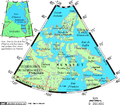Nunavut
Nunavut is a territory in Canada. It is the newest, largest, and northernmost territory of Canada. It was founded on April 1, 1999 when many Inuit living in the Northwest Territories wanted to have an independent province and government. Its capital is named Iqaluit. It is in the north of Canada, and has a particularly cold climate for much of the year. It has many native people (mainly Inuit).
The main form of transportation is the snowmobile. For the first week of being a separate unit, it was the Province of Nunavut, but after a week it was renamed Nunavut Territory.
A symbol of the territory is the Eskimo Dog (qimmiq).[11] Even today, some people still use these dogs.
Gallery
An aerial photo of Nunavut near the Roes Welcome Sound on April 22, 2017
Köppen climate types in Nunavut
Entrance sign to Igloolik Airport, with text in Inuktitut, English, and French[a]
CHARS is one of several Arctic research stations in Nunavut.
The Hope Bay gold mine is one of three major mines in the territory.
The Jericho Diamond Mine is a dormant mine in Nunavut, that operated from 2006 to 2008.
A power station powered by diesel fuel in Rankin Inlet
References
| Wikimedia Commons has media related to Lua error in Module:Commons_link at line 62: attempt to index field 'wikibase' (a nil value).. |
- ↑ Template:Cite cgndb
- ↑ 2.0 2.1 "Population and dwelling counts: Canada, provinces and territories". Statistics Canada. February 9, 2022. Archived from the original on February 9, 2022. Retrieved February 9, 2022.
- ↑ "Nunavut". CanadaFAQ.ca. Archived from the original on April 30, 2020. Retrieved April 25, 2020.
- ↑ "Population estimates, quarterly". Statistics Canada. September 24, 2025. Retrieved September 24, 2025.
- ↑ Nunavummiut, the plural demonym for residents of Nunavut, appears throughout the Government of Nunavut website Archived January 18, 2009, at the Wayback Machine, proceedings of the Nunavut legislature, and elsewhere. Nunavut Housing Corporation Archived October 14, 2022, at the Wayback Machine, Discussion Paper Released to Engage Nunavummiut on Development of Suicide Prevention Strategy Archived May 18, 2022, at the Wayback Machine. Alan Rayburn, previous head of the Canadian Permanent Committee of Geographical Names, opined that: "Nunavut is still too young to have acquired [a gentilé], although Nunavutan may be an obvious choice." In Naming Canada: stories about Canadian place names 2001. (2nd ed.). Toronto: University of Toronto Press. (ISBN 978-0-8020-8293-0); p. 50.
- ↑ "Consolidation of (S.Nu. 2008, c.10) (NIF) Official Languages Act" (PDF). and "Consolidation of Inuit Language Protection Act" (PDF). Government of Nunavut. Retrieved August 5, 2021.
- ↑ "Gross domestic product, expenditure-based, provincial and territorial, annual (x 1,000,000)". Statistics Canada. 2019-09-21. Archived from the original on April 13, 2023. Retrieved September 21, 2019.
- ↑ "Sub-national HDI - Subnational HDI - Global Data Lab". globaldatalab.org. Archived from the original on April 16, 2019. Retrieved 2020-06-18.
- ↑ "The Official Flower of Nunavut: Purple Saxifrage". Legislative Assembly of Nunavut. 2011. Archived from the original on September 23, 2015. Retrieved July 31, 2011.
- ↑ "The Official Bird of Nunavut: The Rock Ptarmigan". Legislative Assembly of Nunavut. 2011. Archived from the original on May 8, 2014. Retrieved July 31, 2011.
Cite error: There are <ref> tags on this page, but the references will not show without a {{Reflist|group=lower-alpha}} template or a <references group="lower-alpha"/> tag.















